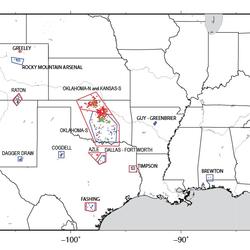Title: Yes, Humans Really Are Causing Earthquakes! How Energy Industry Practices are Causing Earthquakes in America's Heartland
Do all wastewater disposal wells induce earthquakes?
No. Of more than 150,000 Class II injection wells in the United States, roughly 40,000 are waste fluid disposal wells for oil and gas operations. Only a small fraction of these disposal wells have induced earthquakes that are large enough to be of concern to the public.
Learn more:
Related
Is it possible to anticipate whether a planned wastewater disposal activity will trigger earthquakes that are large enough to be of concern?
How does the injection of fluid at depth cause earthquakes?
How large are the earthquakes induced by fluid injection?
Are earthquakes induced by fluid-injection activities always located close to the point of injection?
Is there any possibility that a wastewater injection activity could interact with a nearby fault to trigger a major earthquake that causes extensive damage over a broad region?
Does the production of oil and gas from shales cause earthquakes? If so, how are the earthquakes related to these operations?
Oklahoma has had a surge of earthquakes since 2009. Are they due to fracking?
 PubTalk 5/2018 — Yes Humans really are causing induced earthquakes
PubTalk 5/2018 — Yes Humans really are causing induced earthquakes
Title: Yes, Humans Really Are Causing Earthquakes! How Energy Industry Practices are Causing Earthquakes in America's Heartland
Oilfield waste arrives by tanker truck at a wastewater disposal facility near Platteville, Colo. After removal of solids and oil, the wastewater is injected into a deep well for permanent storage underground. This disposal process has the potential to trigger earthquakes, but very few wastewater disposal wells produce earthquakes.
Oilfield waste arrives by tanker truck at a wastewater disposal facility near Platteville, Colo. After removal of solids and oil, the wastewater is injected into a deep well for permanent storage underground. This disposal process has the potential to trigger earthquakes, but very few wastewater disposal wells produce earthquakes.
Induced seismicity strategic vision
Potentially induced earthquakes during the early twentieth century in the Los Angeles Basin
Reactivated faulting near Cushing, Oklahoma: Increased potential for a triggered earthquake in an area of United States strategic infrastructure
Myths and facts on wastewater injection, hydraulic fracturing, enhanced oil recovery, and induced seismicity
Sharp increase in central Oklahoma seismicity 2009-2014 induced by massive wastewater injection
Shaking from injection-induced earthquakes in the central and eastern United States
Potentially induced earthquakes in Oklahoma, USA: links between wastewater injection and the 2011 Mw 5.7 earthquake sequence
Related
Is it possible to anticipate whether a planned wastewater disposal activity will trigger earthquakes that are large enough to be of concern?
How does the injection of fluid at depth cause earthquakes?
How large are the earthquakes induced by fluid injection?
Are earthquakes induced by fluid-injection activities always located close to the point of injection?
Is there any possibility that a wastewater injection activity could interact with a nearby fault to trigger a major earthquake that causes extensive damage over a broad region?
Does the production of oil and gas from shales cause earthquakes? If so, how are the earthquakes related to these operations?
Oklahoma has had a surge of earthquakes since 2009. Are they due to fracking?
 PubTalk 5/2018 — Yes Humans really are causing induced earthquakes
PubTalk 5/2018 — Yes Humans really are causing induced earthquakes
Title: Yes, Humans Really Are Causing Earthquakes! How Energy Industry Practices are Causing Earthquakes in America's Heartland
Title: Yes, Humans Really Are Causing Earthquakes! How Energy Industry Practices are Causing Earthquakes in America's Heartland
Oilfield waste arrives by tanker truck at a wastewater disposal facility near Platteville, Colo. After removal of solids and oil, the wastewater is injected into a deep well for permanent storage underground. This disposal process has the potential to trigger earthquakes, but very few wastewater disposal wells produce earthquakes.
Oilfield waste arrives by tanker truck at a wastewater disposal facility near Platteville, Colo. After removal of solids and oil, the wastewater is injected into a deep well for permanent storage underground. This disposal process has the potential to trigger earthquakes, but very few wastewater disposal wells produce earthquakes.









